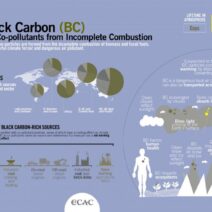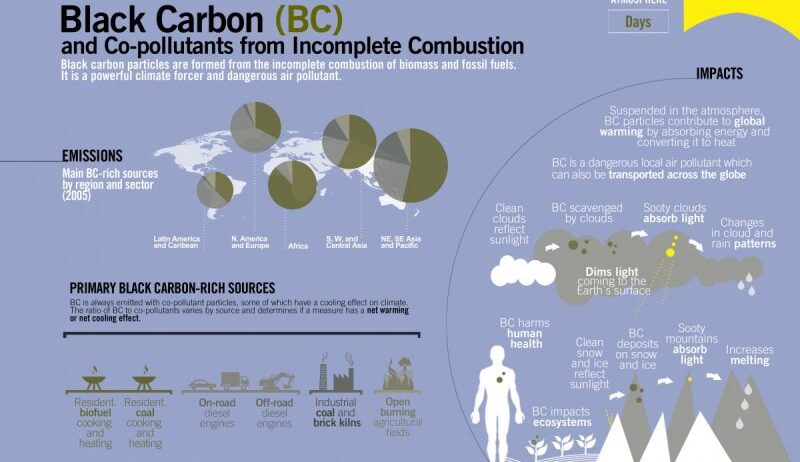Understanding the intricacies of global warming involves delving into a myriad of components that contribute to the phenomenon. One such element, often overshadowed by more commonly discussed greenhouse gases, is black carbon. This pollutant, a product of incomplete combustion of fossil fuels, biofuels, and biomass, is an insidious contributor to climate change. It poses a serious threat to both our atmosphere and the health of countless ecosystems.
Black carbon is not merely a byproduct of industrial processes or forest fires; it represents a significant environmental challenge. When released into the atmosphere, it joins an array of particulate matter that can remain suspended for weeks to months. Unlike longer-lived greenhouse gases, black carbon has a much shorter atmospheric lifetime—yet its effects are immediate and far-reaching. It absorbs sunlight and converts it into heat, warming the atmosphere with a potency several times greater than carbon dioxide (CO2).
Analyzing its origins provides insight into the depths of its impact. Sources of black carbon are both natural and anthropogenic. Natural sources include wildfires and volcanic eruptions, while human activities predominantly originate from the burning of fossil fuels in vehicles and industrial processes, as well as the cooking and heating practices in rural households relying on solid fuels. The juxtaposition of these sources illustrates how deeply intertwined our daily lives have become with the causes of climate disruption.
Upon emission, black carbon particles settle on surfaces, including glaciers and ice sheets. A critical point arises here: when these dark particles are deposited on reflective surfaces, they reduce the albedo effect—meaning less sunlight is reflected back into space. Instead, the absorbed sunlight heats the surrounding ice, accelerating melting processes. This feedback loop creates an alarming scenario where less ice leads to higher temperatures, further exacerbating global warming.
Moreover, black carbon exacerbates atmospheric warming through its interactions with clouds. By influencing the cloud formation and properties, black carbon can lead to the alteration of precipitation patterns. This transformation in weather systems poses severe implications for agriculture, water supply, and biodiversity across the globe.
Interestingly, the gravitas of black carbon extends beyond climate ramifications; it also inflicts dire public health consequences. Particulate matter, including black carbon, has been linked to respiratory diseases, cardiovascular disorders, and even premature death. People living in proximity to high-emission areas, often the most vulnerable in society, experience a heightened risk of health-related issues. This intersection of environmental and human health concerns underscores the urgency of addressing black carbon emissions.
Mitigation strategies targeting black carbon are multifaceted and require a concerted global effort. Technological advancements in cleaner combustion processes present a promising avenue for reduction. Improved fuel standards and the transition to renewable energy sources are imperative. Moreover, innovations in emissions reduction technologies, such as filters and scrubbers for industrial emissions, offer tangible solutions to curtail black carbon output.
Beyond technology, policy interventions hold significant promise for combating black carbon. International agreements, similar to the Paris Agreement, can unify nations in a collective fight against this environmental adversary. Government regulations that impose stringent emissions standards will incentivize industries to adopt cleaner practices. Public awareness campaigns are essential to drive individual actions, from promoting cleaner cooking methods to advocating for cleaner transportation options.
While black carbon is rightly described as a global warming supervillain, the narrative does not end there. The relationship between black carbon and climate change invites deeper reflection on our broader consumption patterns and societal values. The solutions to mitigate black carbon practically hinge upon restructuring how we produce, consume, and live. Holistic approaches that incorporate social equity considerations must underpin any strategy aimed at reducing black carbon emissions.
Furthermore, interdisciplinary research highlighting the connections between economic development, energy use, and emissions can provide valuable insights into effective policy solutions. Collaborations between scientists, policymakers, and the public can foster innovative strategies that are equitable and sustainable.
In summary, black carbon stands as a potent adversary in the fight against global warming. Its multifaceted impacts encompass both atmospheric warming and public health crises. Addressing black carbon will not only contribute to climate mitigation efforts but also enhance air quality and public health outcomes. The urgency of understanding and combating this pollutant is paramount; it requires a unified front that spans geographic, political, and disciplinary boundaries. The fate of our environment—and humanity— hinges upon our ability to recognize, understand, and act against this global warming supervillain.







